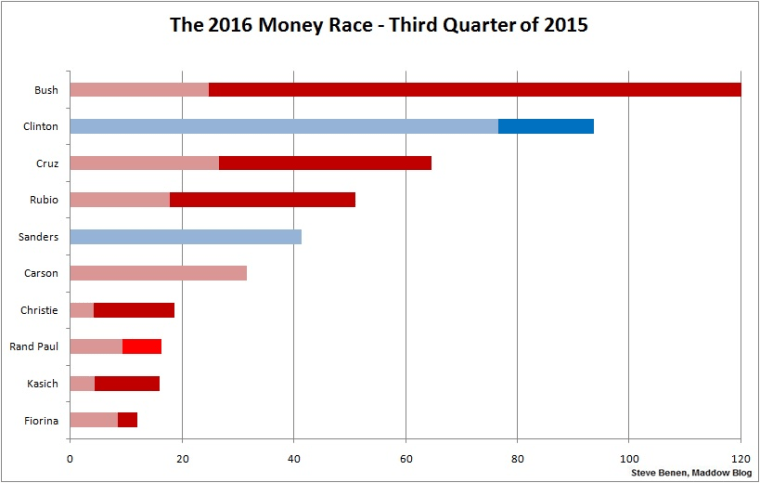
With this in mind, who's winning the 2016 money race? The answer may be unsatisfying, but the truth is, it depends on how you look at the numbers.
I've updated the chart we looked at three months ago, showing how the most competitive candidates are doing based on the most recent filings with the Federal Election Commission. I've omitted candidates who are less competitive, arbitrarily choosing a $10 million cutoff.
Note, the lighter colors -- red for Republicans, blue for Democrats -- show how much money the candidates have raised through their actual campaigns, while the darker colors show how much has been raised by the candidates’ allied entities, most of which are super PACs.
Looking at the chart, a few things jump out right away. For example, the top two contenders for the Democratic nomination -- Hillary Clinton and Bernie Sanders -- are also the top two candidates overall when it comes to taking in contributions directly to their respective campaigns (so called "hard money").
Similarly, though it may not look like Ben Carson and Ted Cruz are dominating the money race among GOP candidates, these two have fared the best among Republicans when super PACs are excluded from the picture.
Jeb Bush, meanwhile, looks like the financial powerhouse of the entire cycle, but the money coming in directly to his campaign is hardly overwhelming -- it's far short of Bernie Sanders' total, for example -- and the former governor is obviously heavily dependent on his Right to Rise operation, which is supposed to function independently of his campaign.
What's more, you'll note that the frontrunner for the Republican nomination, Donald Trump, isn't included in this chart at all, which is itself an oddity -- the hyper-wealthy New York developer has raised about $5.8 million, but it doesn't much matter because of Trump's ability to self-finance his campaign operation.
And then, of course, there's a relevant detail that's easily overlooked: burn rates.
It's one thing for a campaign to raise a lot of money for a prolonged campaign cycle, but candidates who spend much of that money early on may find themselves without the necessary resources when the races for the nominations enter the home stretch.
That's where "cash on hand" comes into play: that's the money candidates still have in the bank. And on this front, Clinton leads all candidates with $33 million, followed by Sanders' $27.1 million. The closest Republican is Cruz with $13.8 million -- which is about half of the money Sanders has on hand.
As we discussed in August, it's worth emphasizing that money does not always translate into votes, and there are plenty of candidates in recent memory who’ve come up short after impressive fundraising hauls (and vice versa). It’s also true that some of these candidates may enjoy vast resources, which they and their teams may invest poorly in the coming months.
That said, as regular readers know, there’s no denying the practical implications of the data for candidates who are struggling. Campaigns with limited resources aren’t able to buy TV time; they tend to have smaller campaign operations in early nominating states; and they often have trouble convincing major donors to write big checks when others aren’t doing the same.